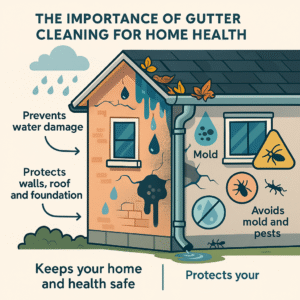Why Is Identifying a Clogged Gutter So Important?
Gutters are one of the key components of any home’s drainage system. They’re designed to guide rainwater away from your roof and exterior walls. When they get clogged, the results can be more serious than you might expect. Standing water caused by a blocked gutter can lead to roof damage, moisture seeping into your walls, peeling paint, and even weakening of your home’s foundation.
These issues often start small but, if ignored, can lead to costly repairs and renovations. That’s why recognizing the early signs of a clogged gutter is crucial. In this guide, Gutters Gurus will walk you through the warning signs and effective ways to spot and fix gutter blockages before they cause major damage.
How to Tell if Your Gutters Are Clogged
A properly functioning gutter system is essential for keeping your home dry and damage-free. But how do you know when it’s blocked? Here are the most common signs to look out for:
Water Overflowing from the Edges
One of the first red flags of a blocked gutter is water spilling over the sides during heavy rain. When water can’t flow through the downspouts, it finds another way out—usually over the edge. This can damage your siding, stain walls, and even lead to rot if left untreated. Routine cleaning can prevent these problems before they escalate.
Damp Stains and Mold on Walls
Persistent water leaks from clogged gutters can lead to damp patches and mold growth on your walls. Over time, this trapped moisture can weaken paint, leave unsightly marks, and even cause structural issues. Keeping your gutters clear helps protect both your home’s appearance and its structural integrity.
Sagging or Bent Gutters
When gutters are weighed down by water, leaves, and debris, they can start to sag or even pull away from your roofline. Not only does this reduce their efficiency, but it also affects your home’s curb appeal. Sagging gutters usually require immediate attention to prevent further damage.
Increased Activity from Birds or Pests
If you notice birds, insects, or rodents gathering near your gutters, it may indicate that debris and moisture have created a perfect nesting environment. Regular inspections can help you spot this early and avoid pest-related issues.
Plants Growing in Your Gutters
If enough dirt and organic matter build up, your gutters can actually become a garden. Seeing weeds or small plants sprouting is a clear sign that your gutter has been clogged for a while and needs immediate cleaning.
The Impact of a Clogged Gutter on Your Home
A clogged gutter isn’t just unsightly—it can cause serious and expensive damage if ignored. Water overflowing from blocked gutters can seep into your roof, walls, and insulation, leading to leaks and structural decay. Persistent dampness may also cause paint to peel and walls to crack.
Water pooling around your foundation can gradually erode the soil and compromise your home’s stability. Ultimately, neglecting these problems could result in costly roof, siding, or even foundation repairs. Regular maintenance by professionals like Gutters Gurus helps you avoid these headaches and keep your home protected.
How to Prevent Gutter Blockages
Prevention is always better than expensive repairs. Here’s how you can keep your gutters in top shape:
Clean Your Gutters Seasonally: Focus on spring and fall when leaves and debris tend to build up.
Install Gutter Guards: Mesh or screen guards can reduce the amount of debris that enters your gutters.
Inspect After Heavy Rain: Check for clogs, leaks, or overflow to catch problems early.
Ensure Proper Slope: A correctly angled gutter allows water to flow freely toward the downspouts.
Use Quality Materials: Durable gutters and downspouts last longer and require less frequent maintenance.
Call the Experts When Needed: Professional services from Gutters Gurus can save you time and ensure your drainage system is functioning at its best.
By following these steps, you’ll protect your home, extend the life of your gutters, and avoid expensive repairs.



